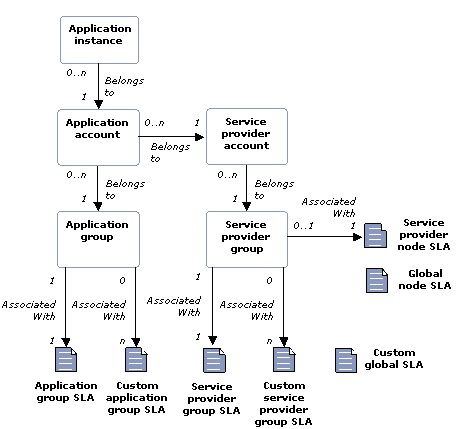







|
An essential part of managing Oracle Communications Services Gatekeeper is dealing with service provider partners. Oracle Communications Services Gatekeeper provides a partner administration model to help operators handle the needs and demands of their partners in a flexible and powerful way:
The SLAs are defined in XML. System SLA have static XSDs and enforcement logic, while custom SLAs are defined in addition to the system SLAs. The XSDs and the enforcement logic for custom SLAs must be developed.
The following SLAs are system SLAs:
The following SLAs are custom SLAs
See Figure 2-1 for an illustration of the relationship among the different account types and SLAs.

The separation of accounts and groups provides a flexible way of defining service level agreements. Groups allow the Oracle Communications Services Gatekeeper administrator to offer tiers of service at both the service provider (via service provider group SLAs) and application (via application group SLAs) level.
Application group SLAs and Service provider group SLAs can be managed and enforced either locally in one site or across geo-redundant sites.
The system SLAs have static XSDs. The enforcement logic is already in place for these types of SLAs, except for the subscriber SLA which needs custom subscriber policy logic.
See Defining Service Provider Group and Application Group SLAs, Defining Global Node and Service Provider Group Node SLAs, and Managing a Subscriber SLA for more information about the system SLAs.
Below is an example of how an Oracle Communications Services Gatekeeper administrator might use system SLAs to create three different categories of service providers:
Each of these would have different privileges when it comes to maximum throughput and QoS parameters. When a new service provider is provisioned, the service provider is associated with an appropriate group based on, for example, the amount of network traffic the service provider is projected to generate. If the outcome is not what was predicted, the service provider account can be reassigned to another service provider group with a different QoS parameter defined in the service provider level SLA.
| Note: | IDs of service provider groups, application groups, application instances, service provider accounts must be unique. The combination of service provider account and application account for an application instance must be unique. |
The service provider and application account and group registrations are performed either through the Oracle Communications Services Gatekeeper Administration Console or through external management systems integrated with Oracle Communications Services Gatekeeper using the Oracle Communications Services Gatekeeper Partner Relationship Management Interfaces or via MBeans. This guide describes many of the tasks associated with establishing and maintaining these accounts and groups using the Administration Console.
| Note: | Service provider accounts, application accounts, and application instances have states that can be changed using OAM, so they can be temporarily be taken out of service. See States of Accounts. |
Custom SLAs are enforced by custom logic that operates on data provided in the SLAs and on data that comes with the request from an application and data about the originator of the request. The request can provide information such as application ID, application instance, service provider ID, application group ID, and service provider group ID. The data in the SLA is formatted according to the SLA XSD, and the enforcement logic uses the Document Object Model (DOM) representation of the XSD to get the data in the SLA.
Custom SLAs can be associated with application groups and service provider groups or be global. A custom global SLA is valid for all requests, regardless of which application group or service provider group the application that triggered the request belongs to.
Custom SLAs are loaded either through the Oracle Communications Services Gatekeeper Administration Console or through external management systems integrated with Oracle Communications Services Gatekeeper using the MBeans.
| Note: | It is also possible to create unique SLAs and groups for an individual application. Accounts can be associated with other groups in runtime, so the class of service can be adjusted over time. |


|